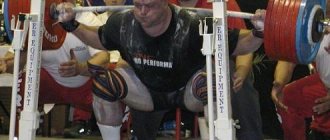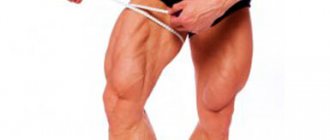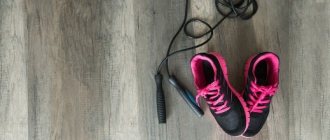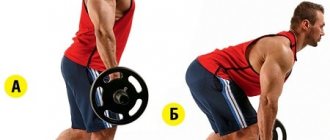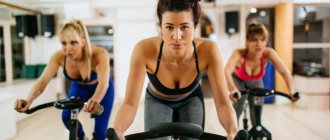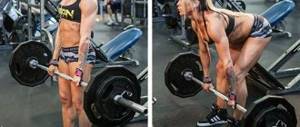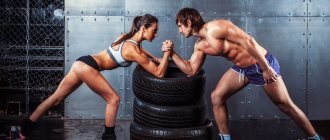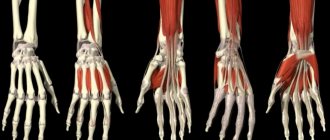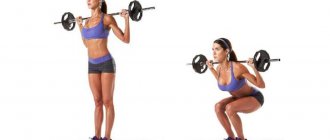To build beautiful legs, it is not enough just to build muscle mass; you also need to achieve the correct proportions and clear definition of the muscles. Sissy squats, an isolating exercise for the quadriceps, help do this. Including sissy squats in the training program allows you to form a beautiful patella zone with a clear separation of the quadriceps heads.
Translated from English, “sissy” means “sissy,” and this does not at all fit with athletes who practice this type of squats. There is a version that the exercise was originally named after the hero of ancient Greek myths Sisyphus, doomed to constantly push a heavy stone upward.
Who is this exercise recommended for?
Sissy squats are performed in a high-repetition mode (from 20 repetitions) without weights or with light weight, so they are not aimed at building muscle volume. Their goal is to achieve a clearer appearance of the lower quadriceps. This isolating exercise is recommended to be included in the training program for experienced bodybuilders who want to bring their hips to perfection.
Beginners can do without this type of squats; they should focus on basic exercises and stretching. It is useless to do sissy squats for those who have a significant layer of fat and do not plan to cut - in this case, the results of fine muscle polishing will not be visible. For the same reason, they will not help girls who have the problem of fat pads above the knees, because muscle training does not affect the layer of fat covering them.
Execution technique
It is advisable to start performing sissy squats after basic leg exercises or after an active warm-up of the knee joints, including rotation, flexion and extension of the knees. Your knees should be well warmed up. The technique for performing the exercise involves the following sequence of actions:
- Stand sideways in a support, holding it with your hand.
- Bring your feet together or place them at a short distance from each other (up to 20-25 cm).
- Bend your knees slightly, lifting your heels off the floor.
- Lean your torso back so that it is in line with your hips. This is the starting position.
- Squat on your toes, bringing your knees forward and leaning back, making sure that there is no flexion at the hip joint, the body and hips should remain in a straight line. You cannot bend your lower back or push your neck forward. Throughout the entire exercise, keep your back straight and do not place your heels on the floor.
- Lower yourself as far as you can, stay in this position for 1-2 seconds and rise to the starting position.
Perform the exercise at a slow pace for 3-4 sets of 20-25 repetitions. If sissy squats are easy, and by the end of the set there is no burning sensation in the muscles, you should not increase the difficulty by increasing the depth of the squats. The angle between the shins and thighs should not be much less than 90°. Complicate the exercises by using weights - you can take a dumbbell in your free hand or hold a barbell plate on your chest.
Everything you need to know about sissy squats
Squats are a key exercise for strengthening your glutes and hamstrings. Three sets with as many repetitions as possible is the basis of any leg workout. However, along with the back surface there is also a front
Pumping it up is no less important, but classic squats do not solve this problem.
It is believed that the exercise received its unusual name from the name of the mythological Sisyphus, whom the gods doomed to roll a stone uphill forever. What is meant, of course, is not the meaning of “Sisyphean labor,” but the pose. A stone can be pushed uphill in two ways: with your hands forward - this is not the case, and with your back - this is exactly the case. And if you look at ancient engravings depicting Sisyphus pushing a stone with his back, you will notice how powerful his legs are.
- The anterior surface of the quadriceps, namely the medial muscle (the so-called small drop) is the attachment to the knee joint.
- Adductor muscles (large, short, long).
- Core muscles.
- The gluteus maximus and calf muscles (as stabilizers).
During the exercise, the main load is placed on the lower part of the quadriceps; the calves, gluteal muscles and the back of the thigh are additionally involved. Let's look at the step-by-step implementation:
- Take a position near a comfortable support, grab it with your hand. You can use a wall bars or a handrail. Keep your back straight, straighten your shoulders;
- Place your feet 20-30 cm apart or together. During the execution, the body weight shifts to the toes. To make sissy squats more comfortable, you can place a block or metal plates under your heels;
- Squat slowly and under control as you inhale, keeping your back straight. Tilt your body back and bend your knees to a right angle. If you bend further, the risk of injury increases significantly. Do not spread your knees to the sides, but move them straight forward;
- Return to the starting position as you exhale. Do not straighten your knees completely, maintain a slight angle;
- In sissy squats, you work with your own weight, especially at first. Over time, you can use weights in the form of a dumbbell or a plate. Hold the dumbbells on straight arms, lowered down, hold the pancake on your chest. Choose a load that you can do 20-25 times.
It should be taken into account that sissy squats create a large load on the knee joints, so you need to do everything carefully and under control. In the lower position, the knees are brought forward further than the line of the toe; this position is already dangerous for injury. This is the main disadvantage of the exercise, which reduces its demand and use.
To build beautiful legs, it is not enough just to build muscle mass; you also need to achieve the correct proportions and clear definition of the muscles. Sissy squats, an isolating exercise for the quadriceps, help do this. Including sissy squats in the training program allows you to form a beautiful patella zone with a clear separation of the quadriceps heads.
Translated from English, “sissy” means “sissy,” and this does not at all fit with athletes who practice this type of squats. There is a version that the exercise was originally named after the hero of ancient Greek myths Sisyphus, doomed to constantly push a heavy stone upward.
Read more: Squat program for men and women: a complex for beginners, how to squat 200 times, training at home
Additional implementation recommendations
To maximize the effectiveness of your training and minimize the risk of injury, when mastering sissy squats, follow these recommendations:
- Never do sissy squats with your knee joints not warmed up - only after basic leg training or a good warm-up.
- Make sure there is no hip flexion during squats, as this will reduce quadriceps isolation and reduce the effectiveness of the exercise.
- In different workouts, it is recommended to use different options for planting the feet, since when the feet are closed, the lateral head of the quadriceps is more loaded, and when they are positioned wider, the medial head is more loaded.
- Throughout the entire exercise, do not straighten your knees completely; they should remain bent.
- To avoid overloading your knee joints, make sure that your knees do not move outward or move inward when squats. At the lowest point, the bend in the knees should not be too large; it is better if the angle is at least 90°.
- Inhale while going down, and exhale while going up.
- Do not try weighted sissy squats until you thoroughly master the technique of performing this exercise.
- Perform squats slowly and smoothly. Jerks and use of inertia are unacceptable.
- Do not take too much weight; its weight should be such that you can perform 20-25 repetitions before failure.
- If you experience the slightest discomfort in your knees, stop doing the exercise.
- To minimize the risk of injury, it is preferable to use less traumatic versions of sissy squats - in the Sissy Squat Machine, a leg press machine with toes placed on the edge of the platform.
Sissy squats are an effective exercise for polishing the relief of the patellar part of the quadriceps muscles. It is recommended to include it in the training program only for experienced athletes who do not have problems with the knee joints. It is better for everyone else to refrain from performing this exercise due to its high risk of injury.
Many bodybuilders who have been training for a long time do not have the issue of gaining muscle mass, which they accumulate in excess over the years of training. And at a certain moment they want to do only its formation. That's what sissy squats are for.
Few people have heard of them, but if you take the training programs of such famous people as Tom Platz, Arnold Schwarzenegger, Vince Gironda, this exercise takes its rightful place in them. It's time to figure out what it is and whether you should include it in your study plans.
Tips and tricks
To maximize the effectiveness of your training and minimize the risk of injury, when mastering sissy squats, follow these recommendations:
- Never do sissy squats with your knee joints not warmed up - only after basic leg training or a good warm-up.
- Make sure there is no hip flexion during squats, as this will reduce quadriceps isolation and reduce the effectiveness of the exercise.
- In different workouts, it is recommended to use different options for planting the feet, since when the feet are closed, the lateral head of the quadriceps is more loaded, and when they are positioned wider, the medial head is more loaded.
- Throughout the entire exercise, do not straighten your knees completely; they should remain bent.
- To avoid overloading your knee joints, make sure that your knees do not move outward or move inward when squats. At the lowest point, the bend in the knees should not be too large; it is better if the angle is at least 90°.
- Inhale while going down, and exhale while going up.
- Do not try weighted sissy squats until you thoroughly master the technique of performing this exercise.
- Perform squats slowly and smoothly. Jerks and use of inertia are unacceptable.
- Do not take too much weight; its weight should be such that you can perform 20-25 repetitions before failure.
- If you experience the slightest discomfort in your knees, stop doing the exercise.
- To minimize the risk of injury, it is preferable to use less traumatic versions of sissy squats - in the Sissy Squat Machine, a leg press machine with toes placed on the edge of the platform.
Read more: Squats with dumbbells between the legs
Sissy squats are an effective exercise for polishing the relief of the patellar part of the quadriceps muscles. It is recommended to include it in the training program only for experienced athletes who do not have problems with the knee joints. It is better for everyone else to refrain from performing this exercise due to its high risk of injury.
Although the exercise belongs to an average level of difficulty and is quite easy to perform with some practice, it still has its own nuances and features.
To maximize the load on the target muscle and minimize the risk of injury, it is recommended to adhere to the following tips:
- Don't make sudden movements. In particular, inertia should not be used, as this can injure the joint. You need to control your movements at every stage of the exercise.
- Do not use weights until you have mastered the correct technique.
- If you start with this exercise, it is recommended to warm up your knee joints well. Don't be lazy and take a few minutes to do good movements.
- As soon as a burning sensation appears in the target muscle, you should immediately finish performing the repetition. This is enough to work the target muscle.
- If there is pain and discomfort in the knee joint, you need to stop. In such cases, it is recommended to replace it with something similar.
About the name
Many people are interested in why the exercise has such a strange name. There are two versions. The first says that the position that must be taken in this squat is very similar to the pose of Sisyphus - the ancient Greek martyr doomed to eternal labor in the kingdom of dark Hades. The second point of view connects the term with the vulgar translation of the word “Sissy” - sissy, mama’s boy.
Muscle work
Not everyone likes sissy squats, considering them useless: they do not build muscle mass, they only work on the beauty of the quadriceps, the technique is complex. Everywhere you look there are only disadvantages. But you just have to look at those athletes who do not disdain the sissy squat, and you will immediately want to have the same stunning thigh contour as theirs. But they achieved this thanks to this particular exercise.
When performed correctly and regularly, it:
- works the front thigh in isolation;
- develops quadriceps;
- forms a clear separation of its heads;
- strengthens the core muscles (and they include the pelvis, hips and spine);
- makes the small muscles of the legs work;
- removes fat from the knees (guarantees the so-called drying of this area);
- develops flexibility and a sense of balance.
Still doubtful about its effectiveness? Learn to perform them correctly - and you will feel the full force of the impact on the leg muscles.
Many girls who are actively involved in bodybuilding are interested in whether it makes sense for them to perform this exercise for the buttocks to make them elastic. It should be noted that any squats exclude a flat, cellulite butt with fat folds. In addition, the core muscles, which include the pelvis, are perfectly strengthened here. So exercise for your health and be beautiful, if your physical fitness allows.
Speaking about the work of muscles during sissy squats, it is worth paying more attention to the joints. This exercise puts increased stress on the knees, which have to be pushed further than the toe line at the bottom. This is very dangerous and is a significant drawback of such training. So any injuries to the knee joints automatically become contraindications for sissy squat.
Interesting fact. Thomas Steven Platz is an American actor and bodybuilder, owner of the most muscular legs in history. Was a fan of sissy squats.
Work of muscles and joints
The main load during chest squats is performed by the quadriceps of the thigh, mainly the lower part of the quadriceps, but the calf muscles are also involved. Unlike many other squats, during which the center of gravity is located in the heel and the outer part of the foot, in this case the athlete rests his toes on the floor, with the knee extending well beyond the line of the toes.
Actually, this alone is enough to, from a biomechanical point of view, load the knee joint, therefore, we emphasize once again, the exercise is performed without additional weights. The unusual form of performing these squats forces you to hold on to a wall or some other object, because otherwise you simply will not be able to maintain your balance.
There are two joints: the knee and the ankle, which have their pros and cons. The main disadvantage is the risk of injury and, as a consequence, the inability of chest squats to use additional weights. The advantage is that it is possible to stretch the ankle very well, so the exercise is also performed in order to more easily maintain the center of gravity in the heels while performing classic squats with a barbell.
In this case, by the way, it is also allowed to use small pancakes to place them under the heel, as this will help to perform the exercise easier. In any case, the priority always remains the correct technique of execution and a slow speed of flexion and extension of the knee joint.
Not everyone likes sissy squats, considering them useless: they do not build muscle mass, they only work on the beauty of the quadriceps, the technique is complex. Everywhere you look there are only disadvantages. But you just have to look at those athletes who do not disdain the sissy squat, and you will immediately want to have the same stunning thigh contour as theirs. But they achieved this thanks to this particular exercise.
When performed correctly and regularly, it:
- works the front thigh in isolation;
- develops quadriceps;
- forms a clear separation of its heads;
- strengthens the core muscles (and they include the pelvis, hips and spine);
- makes the small muscles of the legs work;
- removes fat from the knees (guarantees the so-called drying of this area);
- develops flexibility and a sense of balance.
Still doubtful about its effectiveness? Learn to perform them correctly - and you will feel the full force of the impact on the leg muscles.
Many girls who are actively involved in bodybuilding are interested in whether it makes sense for them to perform this exercise for the buttocks to make them elastic. It should be noted that any squats exclude a flat, cellulite butt with fat folds. In addition, the core muscles, which include the pelvis, are perfectly strengthened here. So exercise for your health and be beautiful, if your physical fitness allows.
Speaking about the work of muscles during sissy squats, it is worth paying more attention to the joints. This exercise puts increased stress on the knees, which have to be pushed further than the toe line at the bottom. This is very dangerous and is a significant drawback of such training. So any injuries to the knee joints automatically become contraindications for sissy squat.
Interesting fact. Thomas Steven Platz is an American actor and bodybuilder, owner of the most muscular legs in history. Was a fan of sissy squats.
Execution technique
To reduce the risk of injury and gain maximum benefit, the technique must be flawless, although it is quite difficult for beginners and will certainly cause difficulties the first time.
The classic exercise is carried out according to the following scheme.
- Stand at any support (it can be a handrail or a wall bars) and grab it with your hand.
- The back is straight, the shoulders are straightened.
- Place your feet either together or at a distance of 25 cm from each other, forming a parallel.
- Keeping your back straight, stand on your toes and begin to tilt your body back, while simultaneously performing a slow squat. Bend your knees to a right angle.
- Flexible and experienced athletes with well-developed knee joints can do deep squats, touching the floor with their knees and their buttocks with their heels. Without proper training, you can easily get injured. Therefore, if you are not sure that you can perform such a trick, do not try it.
- The knees should not diverge to the sides: they can only be moved forward.
- Fix at the lowest point.
- Rise just as slowly.
- In the top position, the knees do not need to be fully straightened.
The technique involves many nuances, which are better to get to know firsthand. Therefore, before you try to do them, watch training videos or ask a trainer to show you the sequence of actions.
It is important! Sissy squats are performed using muscular effort rather than mechanical inertia. Because of this, the speed should be minimal.
There are different variations of sissy squats, which are best mastered after the classics. The first group of exercises is performed in the simulator. The second is with weights (barbell, dumbbells, weights).
In simulators
- Sissy Squat Quad Blaster
This is a machine specifically designed for isolated quadriceps training. Its disadvantage is that it excludes the work of the back of the thigh and buttocks. Another difficulty: the technique must be perfectly clear, and there are no stands behind which you can hold on with your hand, as in the classics.
The fixation roller keeps the shins in a stable position. The back cushion keeps the pelvis in line. To perform squats, you need to stand on the machine, grab the disc with both hands and hold it in front of you. Keeping your back vertical, slowly lower yourself to the limit. Rise just as slowly and smoothly. Do not straighten your knees at the top point.
Trainer LMX1304 Sissybars squat stand PRO
Force USA Sissy Squat Machine
You won't be able to do sissy squats in Smith without the Sissy Squat machine. That is, you will have to combine these two machines. Place the bar at shoulder level. Stand under it so that it is just behind your neck. Stand up and remove the barbell from the rack, holding it with both hands. Check into Sissy Squat. Tilt your torso back, straighten your back. The hips and torso lie in the same plane. Slowly squat down to the limit. Start the movement with your hips, not your knees, providing the main load to your heels. Without jerking, return to the starting position.
With weights
If there is a feeling that your own body weight is not enough, any weight is taken in the hand free from the handrail.
- sissy squats with dumbbells: the apparatus is placed with a free arm extended downwards, which, as an option, can also be moved behind the back;
- with a barbell: the weight plate is held with your free hand directly in front of your chest.
Sissi squat machine
Sissy Squat Quad Blaster is a simulator designed for isolated training of the quadriceps, excluding the work of the back of the thighs and gluteal muscles. Sissy squats are a great alternative to shoulder lunges and are an excellent follow-up exercise after core movements like back squats or leg presses. Contrary to its frivolous name, Sissy Squats* will give results equal to four regular workouts for any athlete, regardless of their fitness level. The simulator allows both exercises with your own body weight and work with additional weights: a barbell, plates, weights or dumbbells.
Fig 1. Sissi squat machine
To ensure maximum strength, the frame of the exercise machine is welded from calibrated steel pipes with a square section of 2 "x 2" x 11. The design does not use bolts or any other fasteners that will weaken over time. Measuring 13" tall by 20" wide, the shin support pad features 2" thick dense foam padding and is designed to reduce contact points between the shin and the back of the knee joint, promoting more even weight distribution across the entire support surface. The steel plate has an anti-slip coating. The leg bolsters are adjustable in length and allow an athlete of any weight and size to securely fix their legs to ensure the best isolation of the quadriceps.
Technical characteristics of the simulator
Size: 64″ long x 27″ wide x 16″ high.
Frame Construction: 2″ x 2″ x 11″ Carbon Steel with up to 75% recycled material
Supports: Support legs and welded end caps.
Manufacturing: To ensure maximum strength and stability, only welding is used.
Calf support measures 13″ high x 20″ wide.
Calf support adjustment: 15" to 23" in 1" increments.
Roller size: 4.5″ long x 8″ wide.
Foot Roller Adjustment: The roller adjusts fore and aft in 1 inch increments and is secured with a pin.
Footrest: The anti-slip base plate is made of 3/16-inch thick steel.
Cover: Marine vinyl, 29 ounces, mildew resistant, easy to clean.
Finish: Clean powder coating is applied electrostatically, then baked at 400 degrees.
To ensure maximum possible safety, it is recommended that the exercise machine be securely secured to the floor using special fasteners.
Fig 2. Fastening to the floor surface
Purpose: Commercial gyms and clubs.
Total machine weight: 60 lbs.
Country of development: USA
One of the possible options for making a sissi simulator:
Fig 3. Option of sissi simulator
Dimensions of the sissi squat device
| From Ulysses Williams' Instagram Yesterday they blew up their legs and finished them off with Sissy squats. On Sissy Squat, Quad Blaster got everything he could out of his legs. I usually don’t work on my abs on leg day, but yesterday was a great opportunity to do two workouts at once: abs and legs on the same machine. If your gym has such a machine, be sure to use it. My exercises:
|
Conversion table for inches to millimeters Conversion table for pounds to kilograms
———
* Sissi squats - girly squats
Translation by
Evgeny Lepyokhin
Post Views: 4,415
Recommendations
For them to be useful, be sure to listen to the recommendations of experienced people who know a lot about this.
- You need to stand on your toes throughout the squat.
- No sudden movements.
- Do not overload your knee joints: lower them no lower than a comfortable level.
- The pause at the bottom point should be no more than 2 seconds.
- Follow your breathing technique: as you inhale, bend your knees, as you exhale, bend your knees.
- No weights until the classic technique is perfect.
- Approximate training scheme: three times a week, 3-4 sets of 20-25 times.
- There should be as many repetitions as possible: do not stop until you feel a burning sensation in the muscles.
- However, there should not be any pain in the knee joints.
- The exercise is best performed in the middle of a workout or at the end of the complex.
- Don't do sissy squats without warming up.
- The body weight rests on the socks. For convenience, you can place pancakes or bars under your heels.
If you want to have beautiful, sculpted quadriceps without additional muscle gain, be sure to adopt sissy squats, which will cope with this task in a short time. Perhaps the execution technique will cause certain difficulties, since the exercise seems simple only at first glance. But after you master the nuances and are able to correctly distribute the load on the right muscles, the results will not take long to arrive and will definitely please you.
As an alternative, consider these other squat variations:
Sissy squats are a bodybuilding exercise. It appeared when athletes noticed that squatting with a working weight on the shoulders and parallel thighs is not very comfortable, and in some cases leads to injuries to the knee ligaments. Athletes and their coaches have experimented with ways to reduce the axial load and increase the stretch of the quadriceps during movement, and this is how this option came about. The movement is performed with the shin fixed in a machine or bench. Despite the best wishes of some athletes, this movement can hardly be called isolating. Yes, it works the quadriceps more than a simple barbell squat, but the hamstrings, calves, and glutes are also included.
Common Mistakes
The supported squats described above may seem like a fairly simple exercise, but they are not. To minimize the likelihood of injury and maximize stress on your quadriceps, use the following tips.
- Avoid sudden movements and use of inertia. Squat as slowly as possible, holding on to the support.
- It is better to refuse weights until you have fully mastered the technique.
- It makes sense to perform the exercise in the middle of a complex workout or at the end of a block of exercises for the leg muscles. If you decide to start a class with sissy squats, be sure to warm up your knee joints. A few minutes of warm-up exercises will protect you from injury.
- Your body will develop harmoniously if you add aerobic exercise to your training plan. If your goal is legs, a bicycle is perfect for you.
- Do as many repetitions as possible. The approach can be completed when a strong burning sensation appears in the muscles.
- If you feel pain or discomfort in your knee joint during an exercise, stop. You might want to replace sissy squats with another safer exercise.
Performing sissy squats will help those who want to achieve ideal shape and definition of their quadriceps. Unlike regular dumbbell or barbell squats, they do not particularly increase the size and muscle mass of the thighs. For the best effect, such squats should be combined with other leg exercises as part of supersets.
Execution technique
Initial position
- Fix your shin in the sissy squat machine, or take the following position - your hand is holding a support, your pelvis is pulled back, your shin is perpendicular to the floor, your lower back is tense and arched. You can squat at a vertical support so that it is between your knees and both hands grab it;
- The stomach should be moderately tucked, the back should be tense so as to prevent swaying to the sides and falling;
- Movement in the hip joint is minimal when squatting without a machine, and is allowed if a shin brace is used;
- Those who do not use the machine must stand on their toes to exclude the classic squat technique from the possible options for performing the exercise.
Movement
- They lower themselves into a squat while inhaling. The pelvis follows the bending of the knees; there is no need to additionally bring it;
- The thighs are parallel to each other, the knees are directed forward. This is the difficulty of the exercise; the hip joint is in a plane that is unnatural for squatting;
- Amplitude - how much flexion in the knee joint allows;
- When returning back, you should smoothly straighten your joints and rise as you exhale.
Attention
- The hip joints move minimally. The position with the knees forward is not anatomically designed for them; athletes must consciously control the position of the body and avoid unnecessary movements in the joint;
- There should be other exercises in the plan that involve bending and extending the knee. They allow you to warm up. If for some reason this auxiliary exercise comes first in the plan, you should warm up thoroughly;
- By its nature, the exercise does not require weights, or is performed with minimal weight held on the chest. The movement helps develop the quadriceps, but is usually performed at the end of the workout, loading these strong muscles on a residual basis.
Sissy squats
Performing sissy without first practicing the technique and basic movements of the exercises is strongly not recommended. Due to the fact that this squat requires the athlete to have excellent body balance, if performed improperly, craving for a beautiful body can lead to serious injuries to the musculoskeletal system.
Regardless of whether you squat with a barbell, dumbbells, or without any additional weight, the basic sissy technique consists of the following steps:
- Stand exactly in front of a stable support, resting one hand on it (when performing squats with dumbbells behind your back, a stand is not needed). Most often, the exercise is performed near a wall bars, but any stable structure will do as a support.
- If you perform an exercise with weight, you need to take it in such a way that the load on the body is distributed evenly. When working with a barbell, take the apparatus on your shoulders (in the case of working with dumbbells, keep your arms with the weight at your sides or move them behind your back). If you work with light weights, you can use barbell plates as a load. In this case, the load is placed on the chest, and the hands are directed forward to hold the pancakes.
- Place your feet at a distance of 25-30 cm or connect them together (heels and toes should be lined up in a single straight line). For convenience, you can put a small stand (no more than 3-5 cm) under your heels, which will also make squats more effective.
- Maintaining the accepted body position, slowly squat down, while tilting your body slightly back. Start body movements from the hips, smoothly bending the hip joint and transferring the bulk of the body weight to the heels.
- Having reached the knee area with your buttocks, you need to lift your body to the top point. At this stage, be sure to ensure that your knees and back remain level, otherwise joint injuries will occur.
- Upon reaching the top point, repeat the squat.
Important! Since the exercise is considered a warm-up, you should work your legs with sissy squats only after a general warm-up. Otherwise, the training may result in serious injury, including to the knee or ankle joints
These variations are performed to work the muscles more deeply, or to work on the weak points of the power movement in powerlifting.
Simulates a stance in a sumo deadlift. Develops hips, buttocks and hip adductors.
The barbell is held on the chest, a clear approach is required. The body cannot tilt forward.
Read more: How to increase your results in squats with a barbell
Zerchera
The barbell is held by bending the elbow, at waist level. The movement serves to correct excessive forward lean in the classic barbell squat.
The barbell is grasped with a straight grip behind the back. Some believe that this works the hamstrings and buttocks better.
Lunge Squat
One of the scissoring movements that corrects leg imbalances is essentially one foot placed slightly back on the toes and the athlete simply lowers into a squat from that position.
The athlete stands on the box, stretches forward or simply lowers the non-supporting leg and performs the movement first with one leg, then with the other. This is necessary to correct the “difference in strength” of the legs.
There are many ways to perform this exercise. Alternate squat variations to target different muscle groups. Squats vary in the location of the center of gravity, depth, placement of the feet, static or dynamic manner of execution.
Squats in many types of sports disciplines are performed with weights (weights, barbells, dumbbells):
- Squats with a barbell on your shoulders. The barbell is located on the upper back (traps). The most productive exercise option. Considered safer than the front squat due to its more stable position. The quadriceps and gluteal muscles work the most. Stabilizers are the hamstrings and spinal extensors.
- Front squats with a barbell. This is a type of exercise in which the bar rests on the front delts. The emphasis shifts to the quadriceps. Deep front squats help increase the efficiency of the clean and jerk, which is useful for weightlifters and crossfitters.
- Squats with dumbbells. They can be used in the gym and for home workouts. Dumbbells (at home, novice athletes often use bottles of sand or water instead) are held in hands, freely lowered along the body. The effects are similar to squats with a barbell on the shoulders, but fewer stabilizer muscles are involved. And the load is usually less, because you can easily load more weight on the barbell and it will be easier to hold it on your back.
A variation of these squats is the goblet squat, which uses one dumbbell (or kettlebell) held at chest level.
By depth
Partial or shallow squats. This type of exercise mainly works only the quadriceps. Most often, it is performed by most beginners and even more experienced athletes, because they cannot or do not want to squat deeper (which is more difficult, although more effective). There is no need to chase weight by doing partial squats, this is traumatic and does not make sense from the point of view of effectiveness in gaining muscle mass.
Squats to parallel. The most common form of squats. The depth of lowering in it is limited to the position in which the thigh is parallel to the floor.
Deep squats. When performing deep squats, the pelvis drops below the knees. This option is the most traumatic for the knee joint due to the large bend of the knees. This squat creates a lot of stress on the buttocks, so it is often used by girls who want to pump up their butt.
Recommendations
- The technique is studied only without weights. For most athletes, especially those who perform a large volume of exercises with knee bending, the sissy squat is indicated only without weight, or with minimal weights;
- Particular attention should be paid to the position of the back. She should not move forward or bend over. If an athlete tries to “fall” forward, then he should rest his free hand on his shoulder and raise his elbow;
- The knees look forward, if they spread to the sides, no matter how the athlete controls himself, it is worth abandoning this movement on the quadriceps, and using something like goblets. This is important to avoid injury to the hip joint. Such moments are determined by the structure of the joints; we cannot simply consciously overcome them or somehow neutralize them;
- During squats, you need to control the position of your shin. If you want to push your shin forward, you should either remove the weight or find a way to fix your shin without a machine. There is an option to perform this exercise on a regular bench - the toes are placed point-blank against the wall, the bench is placed at the back so that the bend of the knee joint is at the level of the bench seat. If necessary, they lift her onto the pancakes, or stand on the pancakes with their feet. Next, the movement is performed in the usual style, but the ankle no longer “rides.” If this does not work, you should consider another option of isolating the quadriceps, since the exercise when the knees “collapse” forward becomes traumatic.
Analysis of movement
What muscles work
- Quadriceps, especially the medial, that is, middle, head of the muscle
Auxiliary:
- In statics, the abs and back work; they provide stabilization of the body in the exercise;
- In dynamics - buttocks, calves and hamstrings, they help in movement
pros
- Suitable for boys and girls, not a serious strength exercise, suitable for spinal injuries, hernias, protrusions;
- Allows you to improve coordination for those who are engaged in bodybuilding programs and do not strive to do basic exercises with a barbell. After some leg presses, sissy squats will seem like something highly coordinated and difficult;
- Helps get rid of imbalance in the development of thigh muscles, which is often found in people who pull a lot, and those who have spent half their life building their buttocks. Simply put, it helps to avoid getting a knee injury at home due to significant hypertrophy of the femoral biceps;
- It helps performers achieve separation, that is, visible separation of the quadriceps heads from each other;
- It improves strength in the context that it helps the development of the quadriceps, which is then actively involved in work in regular squats.
Minuses
- Finding a machine for this exercise is a real challenge. These are usually found only in the “meccas” of bodybuilding. But in an ordinary network club you have to be content with remarkable dexterity and an ordinary bench for exercises;
- The movement is highly specialized. In fitness training, they will not be able to replace a regular squat, or add it instead of some other exercise. In fact, it is needed only to emphasize the load on the quadriceps femoris, and for nothing else;
- The exercise is difficult to perform if the joints are not mobile enough and flexibility is not developed. In this case, you should avoid it.
Preparation for execution
The warm-up complex for this exercise should include work on an elliptical trainer or exercise bike to ensure flexion and extension of the knee joint in a comfortable style.
Proper execution
- This is the only squat variation in which the shin and back are in a parallel plane. There is also a “four” squat in a Smith machine, but it also belongs to the applied arsenal of a bodybuilder and is used extremely rarely in fitness;
- Support is necessary for those who find it difficult to maintain a vertical body position;
- Squat depth cannot be considered a universal value. Each athlete determines it independently and must adjust it according to his own feelings. It is not a competitive powerlifting movement to constantly ensure that the pelvis is below the kneecap;
- In all variations of the exercise, the body weight is concentrated on the front of the arch of the foot, and even on the toes, if the athlete does not use a machine in the exercise;
- Breathing should be calm and smooth; you should not hold it or exhale while lowering your body. Subjectively, lowering the body weight seems more difficult, but in fact the purpose of the exercise is to lift the weight;
- Without support, movement can be handled by those who do not fall forward or backward. If athletes are able to do this exercise without support, this indicates the exceptional development of the vestibular apparatus;
- The exercise can be performed with weights on the chest or in a Smith machine if the athlete is sufficiently prepared and has good joint mobility that allows him to lower himself into a squat without question.
Inclusion in the program
This exercise is never the first thing on the plan. It is “finishing”, it is performed in 3-4 approaches until muscle failure. Therefore, the exercise is done without weight or with minimal weight.
In bodybuilding, it is often done in a superset with front squats or hack machine squats. But this is a tactic of an advanced level of complexity; it is of little use to a novice athlete.
Progression in this movement is usually achieved first by increasing the number of repetitions, and only then by adding working weight. By its nature, the exercise is not strength.
In programs for women, the exercise can be included if a developed quadriceps is required, and emphasis on it. In fitness bikini and simple “for yourself” exercises, the exercise is used quite rarely.
